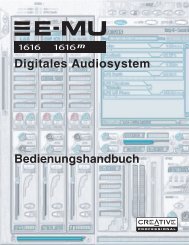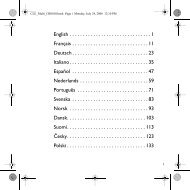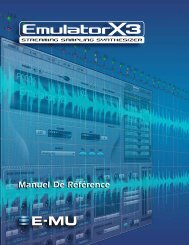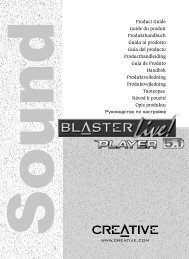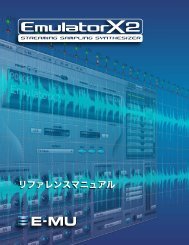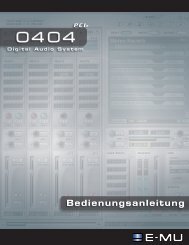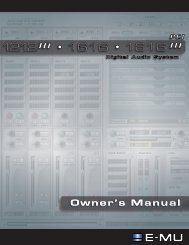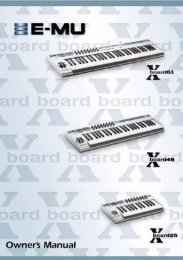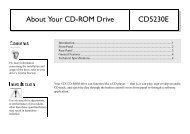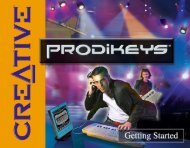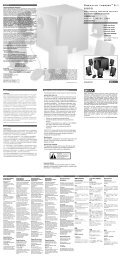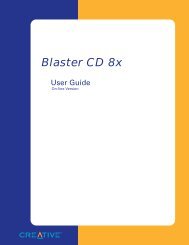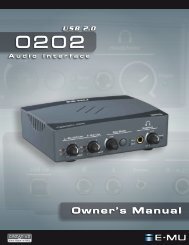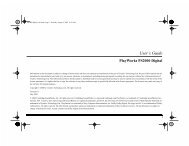Create successful ePaper yourself
Turn your PDF publications into a flip-book with our unique Google optimized e-Paper software.
Stripe Mode<br />
This mode is used to record SMPTE time code onto an audio track of another recorder.<br />
SMPTE is output when the Start button is pressed in the System Settings menu and<br />
begins at the time set by the Start Time setting. MTC is also simultaneously output from<br />
the Sync Daughter Card MIDI out. SMPTE and MTC will continue to be output until the<br />
Stop button is pressed. See Striping SMPTE.<br />
SMPTE Background<br />
SMPTE time code was standardized way back in 1969 by the Society of Motion Picture<br />
and Television Engineers as a way to mark frame numbers on video tape.<br />
Using SMPTE, a particular location can be precisely located by simply entering the<br />
appropriate time code number which is expressed in Hours, Minutes, Seconds, Frames<br />
and Subframes. This is possible because each frame of SMPTE time code contains<br />
absolute location information expressed in digital form.<br />
There are two types of SMPTE time code: Vertical Interval Time Code (VITC), which is<br />
used on video tape and Longitudinal Time Code (LTC) or audio time code. VITC is<br />
strictly used for video and has the advantage of being able to be read while the video<br />
deck is paused. LTC can be recorded on the audio or sync tracks of video tape and can<br />
thus be used in audio or video work.<br />
Longitudinal time code is the type of SMPTE used on the Sync Daughter Card. It<br />
contains 80 bits of information per frame. An audio SMPTE frame is divided into 80<br />
“bit cells”. A voltage change during a bit cell period constitutes a digital “1” and no<br />
change during a bit cell period constitutes a digital “0”. In addition to the location bits,<br />
there are user bits that may contain information about tape reel numbers, bits dealing<br />
with video information, and a 16-bit sync word at the end of the frame.<br />
SMPTE<br />
Time<br />
Code<br />
There are four types of SMPTE time code in general use: 24, 25, 30 frame-per-second<br />
and 30 drop-frame. In general, you should choose one rate (30 non-drop is common in<br />
audio) and stick with it for initial recording and later editing.<br />
Types of SMPTE<br />
Frames Frames Seconds Seconds Minutes Minutes Hours Hours<br />
Start<br />
Frame<br />
10 20 30 40 50 60 70 80<br />
80 Bit Cells per Frame<br />
Bit<br />
Cell<br />
=0 =1<br />
Type Use Hours Minutes Seconds Frames<br />
24 frame US Film 00-23 00-59 00-59 00-23<br />
25 frame Euro. Film + Video 00-23 00-59 00-59 00-24<br />
30 drop-frame US & Japan Color Video 00-23 00-59 00-59 00-29<br />
30 non-drop US & Japan B/W Video 00-23 00-59 00-59 00-29<br />
End<br />
Frame<br />
The four frame rates are all straightforward except 30 drop-frame. The 30 df rate came<br />
about because the US color video frame rate is actually 29.97 frames/sec instead of 30<br />
frames/sec. This adds up to an error of 108 frames each hour relative to “wall clock”<br />
Bit<br />
Cell<br />
SYNC WORD<br />
7 - Appendix<br />
SMPTE Background<br />
E-MU Digital Audio System 71



